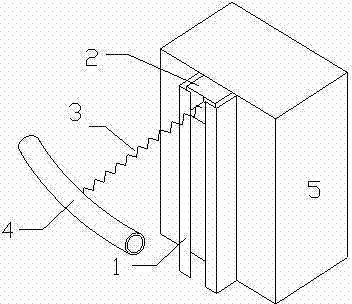Pier collision preventing and energy dissipation device capable of ascending and descending automatically
An energy dissipation device, automatic lifting technology, applied in bridges, bridge parts, bridge construction and other directions, can solve problems such as increasing production and maintenance costs, affecting waterways, and long construction periods, and achieves improved structural utilization, improved absorption effect, The effect of high structure utilization
- Summary
- Abstract
- Description
- Claims
- Application Information
AI Technical Summary
Problems solved by technology
Method used
Image
Examples
Embodiment Construction
[0014] An automatic lifting anti-collision energy dissipation device for bridge piers, including bridge piers 5, its innovation lies in: the automatic lifting anti-collision energy dissipation device for bridge piers is composed of an annular protective sleeve 4, a plurality of connecting springs 3, and a plurality of sliders 2 Composed of multiple guide rails 1; the guide rail 1 is arranged on the outer wall of the pier 5, the axial direction of the guide rail 1 is parallel to the axial direction of the pier 5, and multiple guide rails 1 are distributed along the circumferential direction of the pier 5; the slider 2 is slidingly connected with the guide rail 1 , a plurality of sliders 2 correspond to a plurality of guide rails 1 one by one; the annular protective sleeve 4 is sleeved outside the bridge pier 5, and there is a gap between the annular protective sleeve 4 and the bridge pier 5; one end of the connecting spring 3 and the annular protective sleeve The inner periphera...
PUM
 Login to View More
Login to View More Abstract
Description
Claims
Application Information
 Login to View More
Login to View More - R&D Engineer
- R&D Manager
- IP Professional
- Industry Leading Data Capabilities
- Powerful AI technology
- Patent DNA Extraction
Browse by: Latest US Patents, China's latest patents, Technical Efficacy Thesaurus, Application Domain, Technology Topic, Popular Technical Reports.
© 2024 PatSnap. All rights reserved.Legal|Privacy policy|Modern Slavery Act Transparency Statement|Sitemap|About US| Contact US: help@patsnap.com









